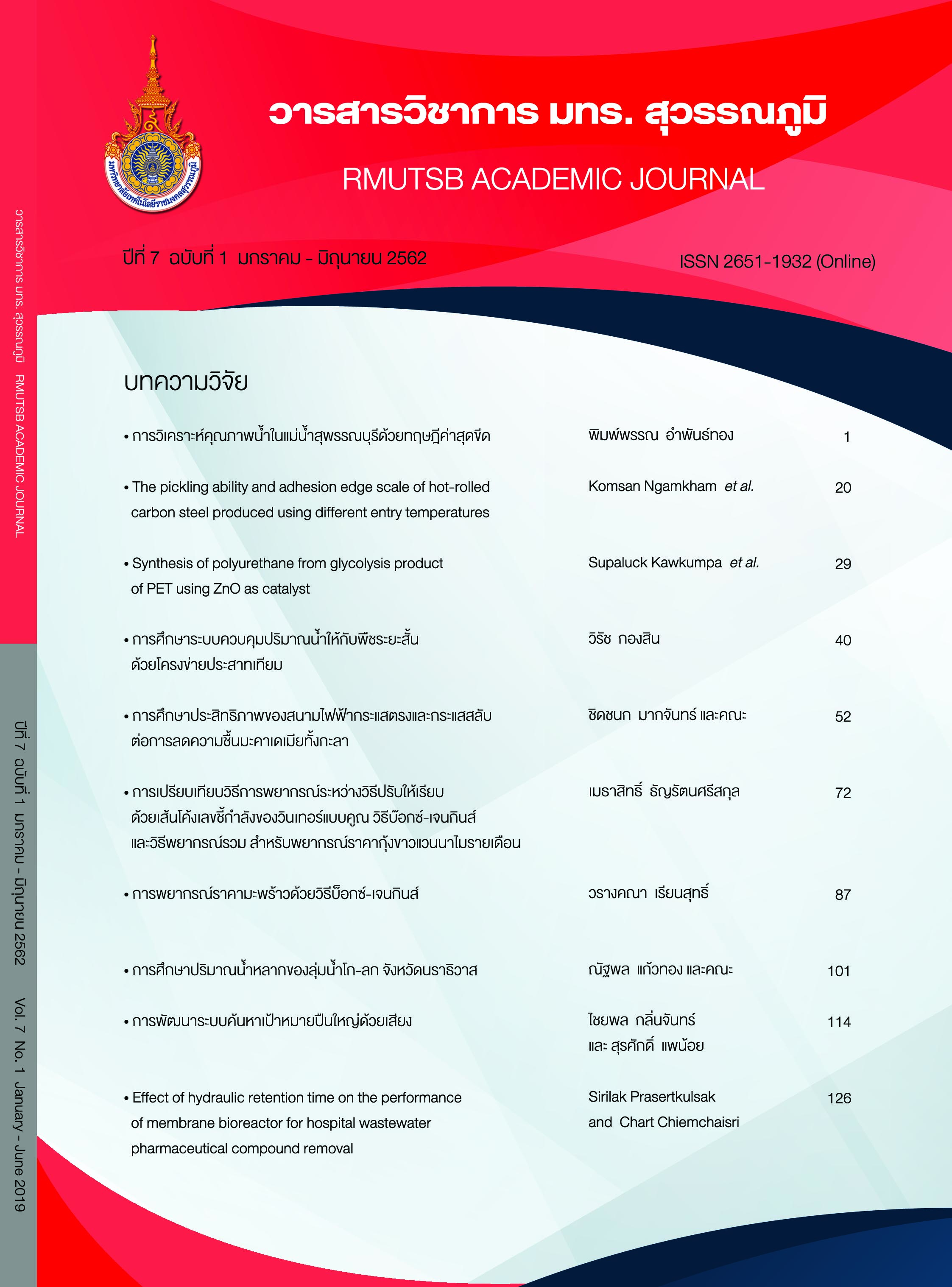A comparison of forecasting methods between Winters’ multiplicative exponential smoothing, Box-Jenkins, and combined methods, for forecasting monthly prices of white shrimp Litopenaeus vannamei
Main Article Content
Abstract
The purpose of this research was to compare three forecasting methods: 1) Winters’ multiplicative exponential smoothing, 2) Box-Jenkins, and 3) combined methods, for forecasting monthly prices of white shrimp Litopenaeus vannamei, size of 70 shrimp per kilogram. The set of time series data of 168 values used in this research was monthly price of the white shrimp from January 2005 to December 2018. The first category of 156 values from January 2005 to December 2017, was used for modeling time series models, and the second category of 12 values from January to December 2018, was used for finding the most suitable forecasting method by the criterion of the lowest mean absolute percentage error (MAPE). The results showed that;
1. The Winters’ multiplicative exponential smoothing model was , where
and
were forecasting values and seasonal indices respectively,
was natural numbers,
was number of time series data, and
=
+
. The correlation coefficient of this model was 0.98.
2. The Box-Jenkins model was SARIMA (1, 1, 0), (0, 1, 1)12 (no constant), presented by , where
and
were forecasting and error values, respectively. The correlation coefficient of this model was 0.98.
3. The combined forecasting model was , where
,
and
were forecasting values form this model, Winters’ exponential smoothing model, and Box-Jenkins model, respectively. The correlation coefficient of this model was 0.98.
4. The most suitable forecasting method for this research was Winters’ multiplicative exponential smoothing method because it had the lowest mean absolute percentage error (MAPE = 16.40), which was less than that from Box-Jenkins method (MAPE=19.10) and combined method (MAPE=17.50).
Article Details
Published manuscript are the rights of their original owners and RMUTSB Academic Journal. The manuscript content belongs to the authors' idea, it is not the opinion of the journal's committee and not the responsibility of Rajamangala University of Technology Suvarnabhumi
References
กัลยา วานิชย์บัญชา. (2555). การใช้ SPSS for Windows ในการวิเคราะห์ข้อมูล. กรุงเทพฯ: จุฬาลงกรณ์มหาวิทยาลัย.
กัลยา วานิชย์บัญชา. (2557). การวิเคราะห์สถิติ: สถิติสำหรับการบริหารและวิจัย. กรุงเทพฯ: จุฬาลงกรณ์มหาวิทยาลัย.
ณัฏฐวดี นิสิยมั่น. (2554). การพยากรณ์ราคากุ้งขาวแวนนาไมด้วยวิธีการของบ๊อกซ์-เจนกินส์ (รายงานผลการวิจัย). ชลบุรี: มหาวิทยาลัยบูรพา.
ดาว สงวนรังศิริกุล, หรรษา เชี่ยวอนันตวานิช, และมณีรัตน์ แสงเกษม. (2558). การศึกษาเปรียบเทียบเพื่อหาตัวแบบที่เหมาะสมสำหรับการพยากรณ์จำนวนผู้ป่วยที่เป็นโรคเฝ้าระวังทางระบาดในกรุงเทพมหานคร. วารสารวิจัยและพัฒนา มจธ, 38(1), 35-55.
วรางคณา กีรติวิบูลย์. (2556). การเปรียบเทียบวิธีการพยากรณ์ระหว่างวิธีบอกซ์-เจนกินส์ วิธีการทำให้เรียบแบบเอกซ์โพเนนเชียลที่มีฤดูกาลอย่างง่าย และวิธีการพยากรณ์รวม สำหรับการพยากรณ์อุณหภูมิเฉลี่ยต่อเดือนในเขตกรุงเทพมหานคร. วารสารวิทยาศาสตร์บูรพา, 18(2), 149-160.
วรางคณา กีรติวิบูลย์. (2557). ตัวแบบพยากรณ์มูลค่าการส่งออกข้าวหอมมะลิ. วารสารวิทยาศาสตร์บูรพา, 19(1), 78-90.
วรางคณา กีรติวิบูลย์. (2558). การพยากรณ์ราคากุ้งขาวแวนนาไม. วารสารวิทยาศาสตร์ มศว, 31(1), 123-140.
ศูนย์อัจฉริยะเพื่ออุตสาหกรรมอาหาร. (2562). อุตสาหกรรมกุ้งไทย. สืบค้น 9 พฤษภาคม 2562, จาก https://fic.nfi.or.th.
ศิริลักษณ์ สุวรรณวงศ์. (2556). เทคนิคการพยากรณ์เชิงปริมาณ: การวิเคราะห์อนุกรมเวลา. นครปฐม: มหาวิทยาลัยมหิดล.
สำนักงานเศรษฐกิจการเกษตร. (2562). กุ้ง: ราคากุ้งขาวแวนนาไมขนาด 70 ตัว/กิโลกรัม รายเดือนที่เกษตรกรขายได้ที่ฟาร์มทั้งประเทศ ปี 2547-2562. สืบค้น 20 มกราคม 2562, จาก https://www.oae.go.th/monthlyprice.html.
เสาวณิต สุขภารังษี. (2542). การพยากรณ์แนวโน้มของการเกิดโรคที่ต้องเฝ้าระวังทางระบาดวิทยาของจังหวัดฉะเชิงเทรา. สืบค้น 13 เมษายน 2562, จาก https://cuir.car.chula.ac.th/handle.
Box, G. E. P., Jenkins, G. M., & Reinsel, G. C. (1994). Time series analysis: Forecasting and control. New Jersey: Prentice Hall.
Farnum, N. R., & Stanton, L. W. (1989). Quantitative forecasting methods. Boston: PWS-KENT Publishing Company.
George, A. F. (1989). Statistical analysis in psychology and education. New York: McGraw-Hill.
Hinkle, D. E, William, W., & Stephen, G. J. (1998). Applied statistics for the behavior sciences. New York: Houghton Mifflin.
Wei, W. W. S. (2006). Time series analysis univariate and multivariate method. Boston: Pearson Addison Wesley.
Winter, P. R. (1960). Forecasting sale by exponentially weighted moving average. Management Science, 6(3), 324-342.

